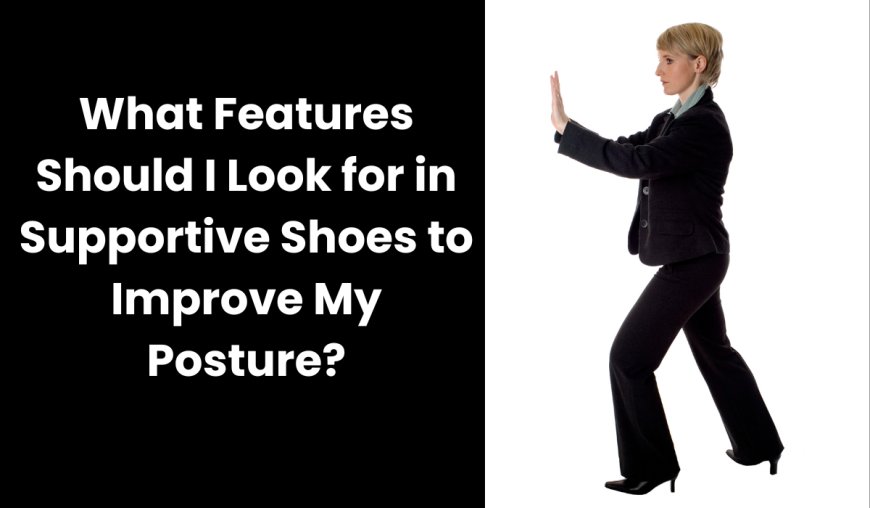What Features Should I Look for in Supportive Shoes to Improve My Posture?
Discover how supportive shoes can dramatically improve your posture, reduce pain, and enhance mobility. Learn the 8 key features to look for in posture-correcting footwear.

Posture isn't just about standing up straight — it's about how your entire body aligns and functions. Poor posture can lead to chronic pain, fatigue, and even reduced mobility. While many people focus on exercises and ergonomic furniture to fix posture, they often overlook one of the most fundamental tools: their shoes. Supportive footwear is not a luxury; it’s a necessity for proper alignment.
The right shoes act as the foundation for your body’s posture and can dramatically affect how your spine, hips, knees, and feet interact with gravity and movement.
So, what features should you look for in supportive shoes to improve your posture? Here are the key elements that matter most.
1. Arch Support
The arch of your foot acts like a shock absorber. It helps distribute body weight evenly and supports the alignment of your knees, hips, and lower back.
When a shoe lacks proper arch support, your feet can collapse inward (overpronation) or outward (underpronation), throwing your entire posture out of alignment.
Look for shoes that offer:
-
Firm but flexible arch support, tailored to your foot type (high, normal, or flat arch).
-
Orthotic-friendly designs, allowing custom insoles if needed.
-
Consistent arch structure that doesn’t compress easily over time.
Arch support isn’t just about comfort; it’s a biomechanical necessity.
2. Heel Stability
The heel is your landing pad, and a stable heel controls the initial contact your foot makes with the ground. A shoe with a stable heel counter — the stiff part that wraps around the back of your foot — helps keep your ankle aligned, which influences everything above it.
You want:
-
A firm heel counter that doesn’t collapse when squeezed.
-
Moderate heel elevation, around 1 to 1.5 inches, to slightly tilt the pelvis forward and encourage a neutral spine.
-
Cushioned but supportive heel padding, which absorbs impact without encouraging heel-strike dominance.
Stability at the heel helps set the tone for how the rest of your body engages with each step.
3. Cushioning Without Sacrificing Support
While cushioning makes shoes comfortable, too much can be a problem. Ultra-soft shoes might feel great at first, but they often lack the structure needed to support proper alignment. Think of it like walking on a memory foam mattress — cozy, but not ideal for posture.
Ideal cushioning should:
-
Absorb impact, especially in the heel and forefoot.
-
Provide energy return, helping your foot move naturally through the gait cycle.
-
Work in tandem with the shoe’s structure, not replace it.
The goal is to find a balance — enough softness to protect joints, but enough firmness to guide good posture.
4. Wide Toe Box
Cramming your toes into narrow shoes doesn’t just cause blisters or bunions. It limits natural toe splay, which is essential for balance and posture. Your toes need space to spread out and grip the ground properly, especially when standing for long periods.
A good shoe for posture should have:
-
A naturally shaped toe box that mimics the shape of your foot.
-
Room for toes to move, especially the big toe, which plays a major role in stability.
-
No upward curve at the toes (toe spring), which can disrupt foot mechanics.
More room in the toe area translates to a more stable, grounded base for the rest of your body.
5. Midsole Support and Flexibility
The midsole is the engine room of your shoe — it controls movement and provides the link between cushioning and stability. If it’s too stiff, it can restrict natural motion. Too soft, and it doesn’t guide the foot correctly.
Look for midsoles that offer:
-
Torsional rigidity — the shoe shouldn’t twist easily.
-
Targeted flexibility at the forefoot, allowing a smooth toe-off.
-
Supportive materials like EVA or dual-density foam that resist breakdown over time.
A well-structured midsole helps your feet roll naturally through each step, supporting the kinetic chain that keeps your spine upright.
6. Proper Fit
Even the most advanced shoe can’t help your posture if it doesn’t fit right. Poorly fitting shoes can cause you to compensate with your hips, knees, and back — the very things you’re trying to protect.
Key fit features include:
-
Adequate length, leaving about a thumb’s width between your longest toe and the end of the shoe.
-
Snug but not tight midfoot, to keep the shoe secure.
-
No slipping at the heel, which can lead to instability.
Make sure to try shoes on later in the day when feet are naturally more swollen, and wear the socks you plan to use daily.
7. Outsole Grip and Stability
The outsole is your interface with the ground. Good traction prevents slips and missteps, while the layout of the outsole (such as lateral flares or stabilizing patterns) can influence how your body moves through space.
You want:
-
Non-slip tread, especially if you walk on a variety of surfaces.
-
Wide, stable base, particularly at the heel and forefoot.
-
Even sole thickness, avoiding extreme rocker soles unless medically indicated.
A solid outsole gives you a confident stride and stable footing — both crucial for maintaining upright posture.
8. Durability and Longevity
Supportive shoes are an investment in your health. Worn-out shoes lose their structure, compress their cushioning, and stop doing the job they were designed for. Always check the expected lifespan of a shoe (typically 300–500 miles for walking or running shoes) and replace them as needed.
Choose shoes made from:
-
High-quality materials that maintain shape.
-
Reinforced seams and overlays in high-stress areas.
-
Brands with a reputation for biomechanical support, not just fashion.
It’s better to rotate two pairs than to overuse one until it's no longer supportive.
Final Thoughts
Improving posture isn’t just about standing tall — it’s about building from the ground up. Your shoes play a crucial role in how your body aligns, moves, and stabilizes throughout the day. The best supportive shoes don’t just cushion your steps; they actively guide your body toward better posture. Focus on arch support, heel stability, proper fit, and overall structure. The more intentional you are with your footwear, the more naturally your posture will follow suit.
Remember: posture starts at your feet. Choose wisely, and the rest of your body will thank you.







































































































![Building A Digital PR Strategy: 10 Essential Steps for Beginners [With Examples]](https://buzzsumo.com/wp-content/uploads/2023/09/Building-A-Digital-PR-Strategy-10-Essential-Steps-for-Beginners-With-Examples-bblog-masthead.jpg)


















































